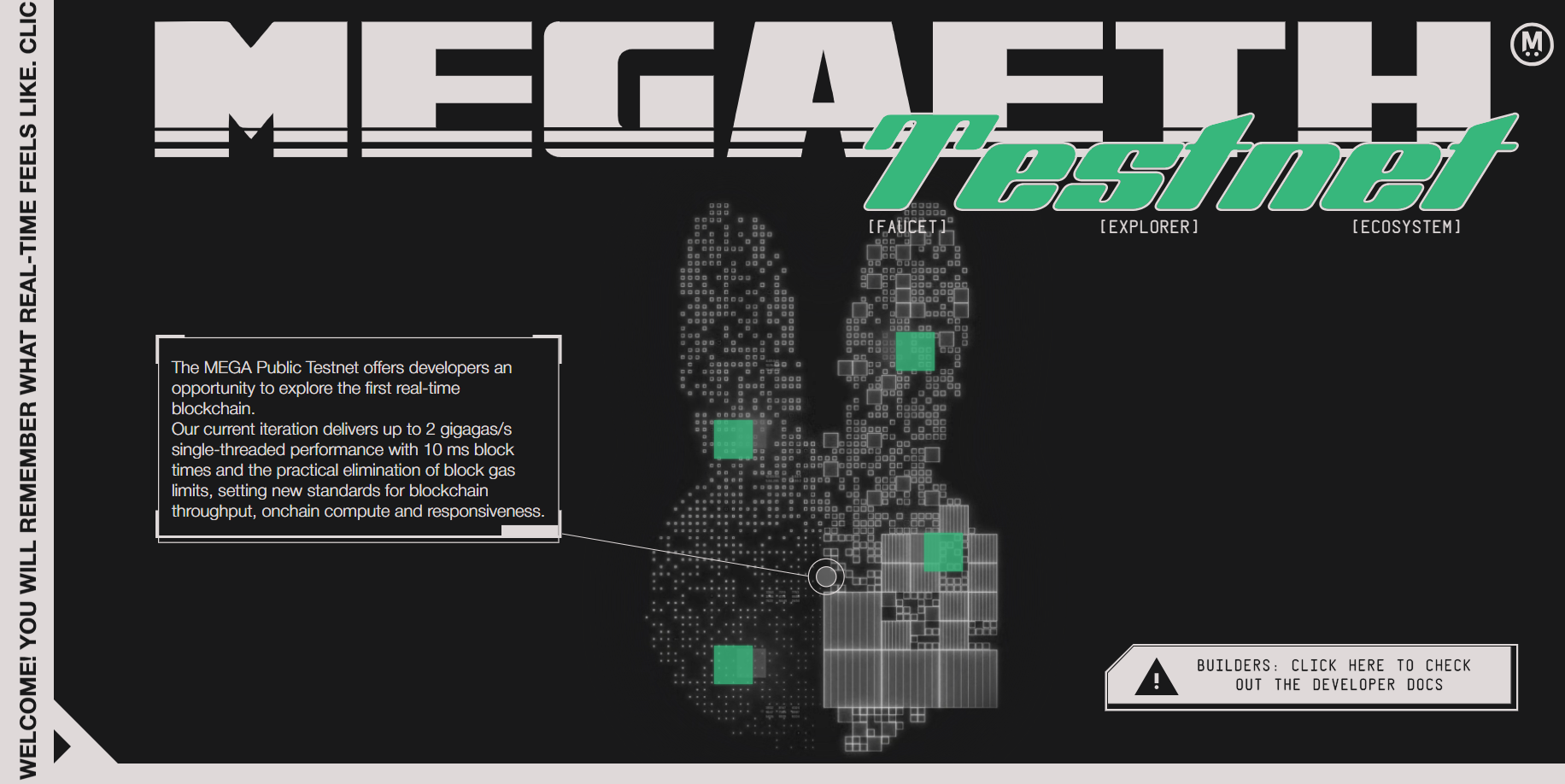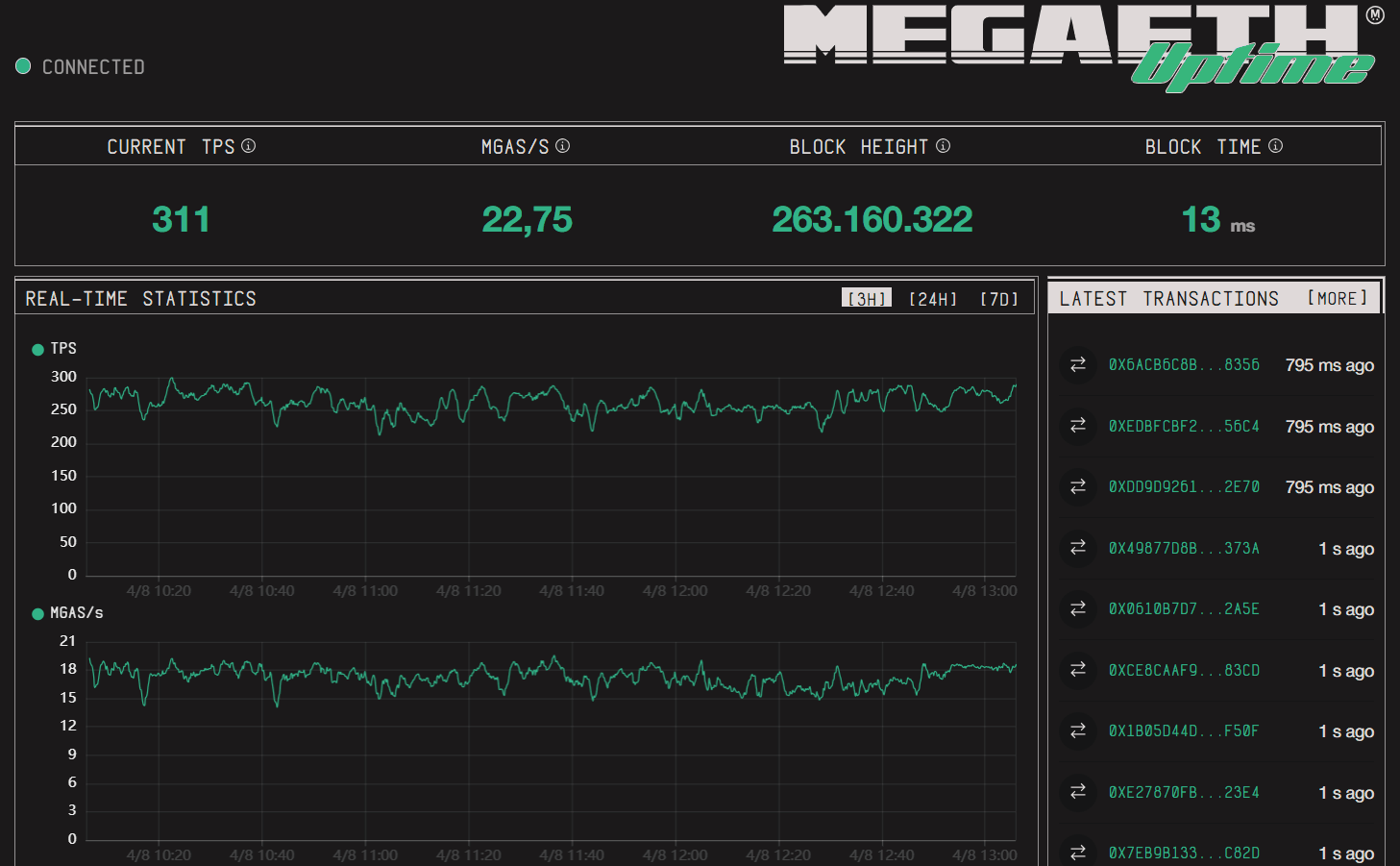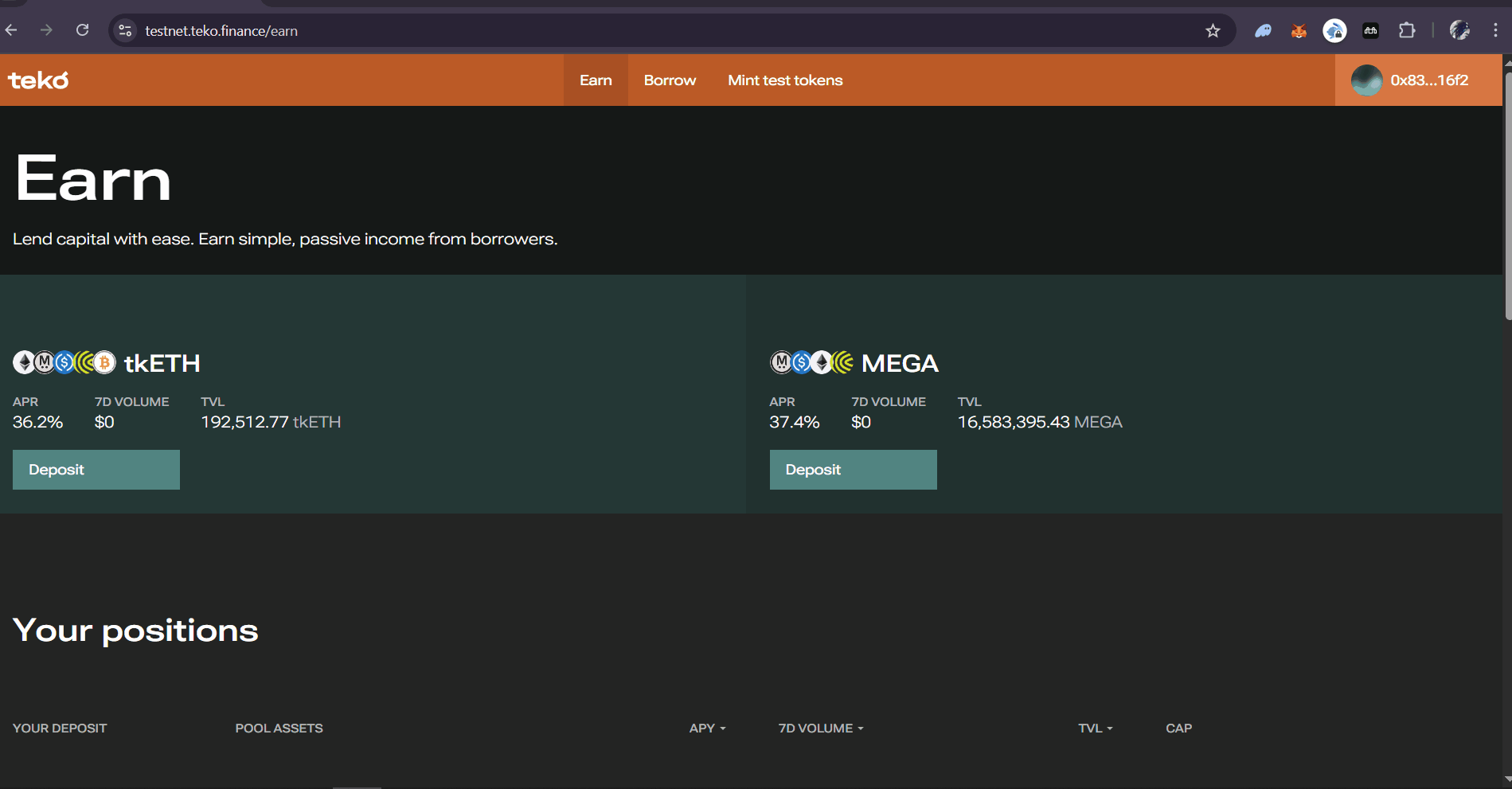MegaETH Testnet | A real-time blockchain, with 10 MS block times and throughput of up to 2 gigagas/s on a single thread! [EN/ES]
hive-167922·@vikvitnik·
0.000 HBDMegaETH Testnet | A real-time blockchain, with 10 MS block times and throughput of up to 2 gigagas/s on a single thread! [EN/ES]
<div class="text-justify"> <div> Blockchain technology seems to be reinventing itself as time goes by. Let's just say that at this very moment there are developers committed to delivering a product that manages to far surpass the current technology. These advancements are being seen much more frequently, not only because of the capabilities of a team looking to innovate, but also because of the existence of AI, which is considered a catalyst for technologies. >La tecnología blockchain parece reinventarse a medida que pasa el tiempo. Digamos que en este preciso momento hay desarrolladores comprometidos en entregar un producto que logre superar ampliamente la tecnología actual. Estos avances se están viendo con mucha más frecuencia, no solo por las capacidades de un equipo que busca innovar, sino también por la existencia de la IA, que es considerada un catalizador de tecnologías. --- <center></center> --- I am particularly surprised by the speed of block times. In a blockchain this is the time it takes to include in a block relevant data with respect to a set of transactions. For example, if we use Hive as a reference model, it can be said that the block times of our blockchain occur every 3 seconds, which makes our chain considerably fast. We can reinforce this idea with the caveat that in Bitcoin, blocks are created every 10 minutes, in Ethereum they are generated in an average of 12 seconds, and Solana, considered one of the fastest currently, is estimated to create blocks every 0.4 seconds. Obviously the speed at which blocks are generated has to do with what protocols are handled and what mechanisms are used. I think that you don't necessarily have to have the lowest rate of speed and latency, because supposedly there are different uses, as well as purposes that adapt to the architecture of your technology. Even so, it is noteworthy that “impossible” things are being achieved that amaze and generate some excitement for a truly amazing future. With the arrival of MegaETH, in its Testnet stage, it is estimated that block times now go from seconds to milliseconds, being considered a real-time blockchain. If we go into details, block times point to 10 milliseconds, with the great detail that parallelization is not required as in other blockchain to accelerate processing times, because in this one, everything happens through a single thread. In addition, something that we should mention and that I consider important is the issue of gigabytes. It is estimated that this large amount of units (2 gigagons/second) allows an immense transfer processing capacity in contrast to a single ETH transfer. This is why the project being built claims that it is possible to perform up to 100 thousand transactions per second, in theory, which is mind-blowing. >Particularmente me sorprende la velocidad de los tiempos de bloque. En una blockchain se trata del tiempo en que se tarda en incluir en un bloque datos relevantes con respecto a un conjunto de operaciones. Por ejemplo, si utilizamos a Hive como modelo de referencia, se puede decir que los tiempos de bloque de nuestra blockchain ocurren cada 3 segundos, lo cual vuelve a nuestra cadena considerablemente rápida. Podemos reforzar esta idea con la salvedad de que en Bitcoin, los bloques se crean cada 10 minutos, en Ethereum se generan en un promedio de 12 segundos, y Solana, considera una de las más rápidas actualmente, está estimada en la creación de bloques cada 0.4 segundos. > >Obviamente la velocidad en que se generen los bloques tienen que ver con qué protocolos se manejen y qué mecanismos se utilicen. Soy de pensar que no necesariamente se tiene que tener el índice más bajo de velocidad y latencia, porque supuestamente hay diferentes usos, como también propósitos que se adapten a la arquitectura de su tecnología. Aún así, es de destacar que se están logrando cosas "imposibles" que maravillan y generan cierta emoción por un futuro realmente asombroso. > >Con la llegada de MegaETH, en su etapa de Testnet, se estima que los tiempos de bloques ahora pasan de segundos a milisegundos, considerándose una blockchain en tiempo real. Si entramos en detalles, los tiempos de bloque apuntan a los 10 milisegundos, con el gran detalle de que no se requiere de la paralelización como en otras blockchain para acelerar los tiempos de proceso, pues en esta, todo ocurre a través de un hilo único. Además algo que deberíamos mencionar y que considero de importancia es el tema de los gigagas. Está estimado que esta gran cantidad de unidades (2 gigagas/segundo) permiten una inmensa capacidad de procesamiento de transferencias en contraste con una transferencia de ETH simple. Por esta razón es que el proyecto que se está construyendo asegura que es posible realizar hasta 100 mil transacciones por segundo, en teoría, lo cual es alucinante. --- <center></center> --- From a technical point of view, this feat is possible thanks to the implementation of an architecture that supports considerably low latencies when requesting certain information from the API. MegaETH has an optimized extension of Ethereum's JSON-RPC API that it can query. This information was previously executed by the system through a sequencer, to which it receives a set of transactions that must then issue the corresponding preconfirmations and execution results in times around 10 milliseconds. Unlike traditional Ethereum blocks, under this architecture, use is made of miniblocks. We can interpret these as blocks that are made up of ordered lists that handle a specific data structure (Merkle) to be extremely efficient, to the point that the latency in the communication between mini-blocks and nodes is considerably low, as well as their processing and verification. Mind you, MegaETH is still a layer 2 solution that seeks to optimize its network transactions as much as possible. But this does not mean that it does not need to make use of EVM blocks as a bridge to the main Ethereum layer. In fact, the system is devised with the aim of being fully compatible, having extreme speed on the one hand, and the goodness of the core layer on the other as a means of end results. >Desde el punto de vista técnico, esta hazaña es posible gracias a la implementación de una arquitectura que soporte latencias considerablemente bajas al momento de solicitar cierta información a la API. MegaETH posee de una extensión optimizada de la API JSON-RPC de Ethereum a la cual puede consultar. Esta información anteriormente fue ejecutada por el sistema a través de un secuenciador, al que le llega un conjunto de transacciones que luego debe emitir las correspondientes preconfirmaciones y resultados de ejecución en tiempos que rondan los 10 milisegundos. > >A diferencia de los bloques tradicionales de Ethereum, bajo esta arquitectura se hace uso de minibloques. Podemos interpretar que se tratan de bloques que están conformados por listas ordenadas que manejan una estructura de datos específica (Merkle) para ser extremadamente eficientes, al punto de que la latencia en la comunicación entre mini bloques y nodos sea considerablemente baja, al igual que su procesamiento y verificación. > >Eso sí, MegaETH sigue siendo una solución de capa 2 que busca optimizar al máximo las transacciones de su red. Pero esto no significa que no necesite hacer uso de los bloques EVM como un puente a la capa principal de Ethereum. De hecho, el sistema está ideado con la finalidad de ser totalmente compatibles, disponiendo de velocidad extrema por un lado, y las bondades de la capa base por el otro como medio de resultados finales. --- <center></center> --- As with any project that has a marked path towards the launch of its mainnet, it can be inferred that its technology will improve drastically as each one of its sections is fine-tuned. In this roadmap, obstacles that could mean a paradigm shift have been overcome. The bottleneck that prevented Merkle trees from exceeding 0.7 gigagons per second has been removed. This led to block times of 10 milliseconds, with the scaling to gigag/second, and we are currently in the stage of synchronizing the sequencer with the rest of the network at superfast speed. The next step is expected to be to boost the performance of the EVM thread to over 2-5 gigag/second. Much more ambitious goals are to eliminate block gas limits, which would lead to an average of 10-100 gigabits per second and block times as low as 1 millisecond through a parallel transmission EVM. >Como todo proyecto que tiene un recorrido marcado hacia el lanzamiento de su mainnet, se puede inferir en que su tecnología mejorará drásticamente a medida que puntualicen en cada uno de sus apartados. En esta hoja de ruta se han superado obstáculos que podrían significar un cambio de paradigma. Se ha logrado remover el cuello de botella que impedía sobrepasar los 0.7 gigagas por segundo en los árboles de Merkle. Esto derivó a lograr unos tiempos de bloque de 10 milisegundos, con la escalada a gigagas/segundo, y actualmente estamos en la fase ya cumplida de sincronizar el secuenciador con el resto de la red a una velocidad súper rápida. Se espera a que el siguiente paso sea impulsar el rendimiento del hilo EVM, de forma tal que se logre superar los 2-5 gigagas/segundo. > >Otro objetivos mucho más ambiciosos son los de lograr eliminar los límites de gas en los bloques, lo que nos llevaría a alcanzar una media de 10-100 gigagas por segundo y tiempos de bloque de tan solo 1 milisegundo a través de un EVM de transmisión paralela. --- <center></center> --- <center>*Truly shocking, isn't it? This and much more is being built, which could change the way we do business today. I hope you found it interesting, and thanks for visiting this article.*</center> ><center>*Realmente impactante, ¿verdad? Esto y mucho más se está construyendo, lo que podría llegar a cambiar la forma en que realizamos transacciones en la actualidad. Espero te haya parecido interesante, y gracias por visitar este artículo.*</center> </div> <center></center> - Information accessed at [testnet.megaeth.com](https://testnet.megaeth.com/) and [docs.megaeth.com](https://docs.megaeth.com/). - Screenshots in gif format made with ScreenToGift. - Translated to English with DeepL. Posted Using [INLEO](https://inleo.io/@vikvitnik/megaeth-testnet-a-realtime-blockchain-with-10-ms-block-times-and-throughput-of-up-to-2-gigagass-on-a-single-thread-enes-9cr)
👍 taskmaster4450le, galberto, rodent, tariksaran, oakshieldholding, lnakuma, warmstill, globalcurrencies, cmplxty.leo, hykss.leo, alokkumar121.leo, maxelitereturned, robmojo.leo, jocieprosza.leo, foreverhero, heteroclite, luchyl, town-hall-voter, lbi-leo, lbi-token, partytime.inleo, teutonium, mindtrap-leo, pouchon, pouchon.tribes, khan.dayyanz, no-advice, steemychicken1, lisamgentile1961, beststart, rtonline.leo, alz190, bilpcoinbpc, godfather.ftw, leo.tasks, scaredycatguide, niallon11, leo.voter, saboin.leo, surya1adiga, onemoretea, repayme4568, bokica80, moretea, scooter77, adambarratt, gadrian, gallerani, dlike, steemaction, dexcrypto, invest.country, mukund123, hive-world, dhedge, officialhisha, grosh, leoschein, leo.tokens, brando28, utopis, creodas, cervantes420, mintfinch, zeclipse, khaltok, neal.power, contestbox, toryfestus, nothung, jeffjagoe, bitrocker2020, ijatz, carl05, leo.bank, rmsadkri, valdiva, v10r8, yozen, elongate, newbies-hive, banzafahra, rzc24-nftbbg, njker, tonton23, kilvnrex, cindy911, dahpilot, ismartboy, go-kyo.leo, slimeyph, sepracore, arrliinn, getron, raiseup, aiuna, anonsteve, pervitin, megavest, x9ed1732b, amongus, steentijd, djrockx, inibless, humbe, newbreed, scraptrader, modiji, tebesc, calebmarvel01, shortsegments, kevinwong, joeyarnoldvn, felt.buzz, etblink, steemxp, flyingbolt, davidbright, venarisyndicate, hiveaction, divinekids, edian, babytarazkp, l337m45732, logicswap, agro-dron, uwelang, leprechaun, teamvn, balvinder294, ragnarhewins90, senorcoconut, holovision.stem,